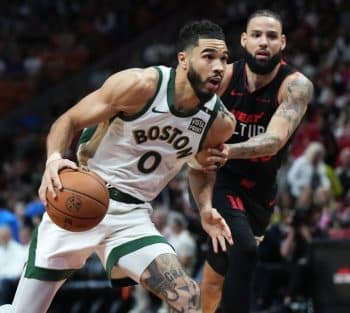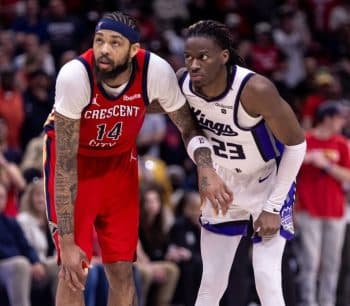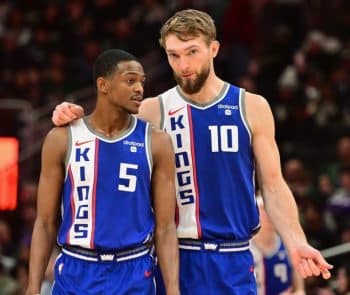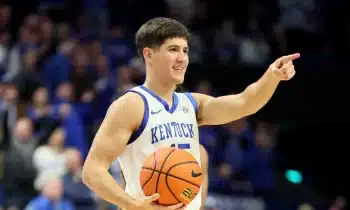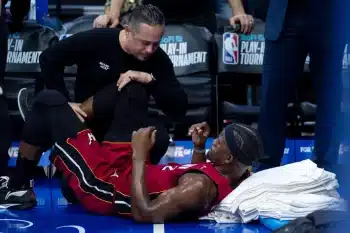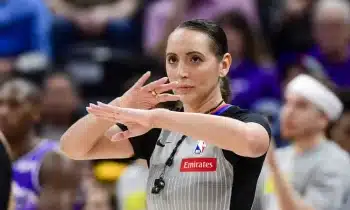NBA
NBA PM: How Defensive Player of the Year Favorites Excel

When we think of basketball players who make their teammates better, it’s most common to consider these concepts offensively. An elite passer makes the game easier for teammates by setting them up for easy shots, a knockdown shooter makes creating those lanes easier by providing spacing and a gravity-inducing roll man can do much of the same in different ways.
The theme isn’t unlike many within the game: It’s much easier to describe and quantify offensively, but the true representation of this sort of player might come on the other end. As it turns out, several of the top candidates for Defensive Player of the Year are fantastic embodiments.
Before we get to the three-man ballot, a nod to one name who isn’t appearing this year, but might represent this theme just as well as anyone.
Just like LeBron James hasn’t vacated the title of world’s best player despite an MVP campaign that feels increasingly unlikely, Kawhi Leonard hasn’t given up the crown of “best perimeter defender alive” despite the possibility that he won’t three-peat for DPOY. His exclusion from the final triumvirate here is as much a nod to what each of these three have done as it is a knock on Leonard’s season.
The Spurs’ defensive performances with Kawhi on and off the court have been covered ad nauseam all year long, and with reason. They’re just curious. San Antonio doesn’t appear to have many other elite-level defenders on paper, which makes the fact that they’re nearly 10 points per-100-possessions better defensively when Leonard sits on the bench – roughly the difference between a league average unit and one of the stingiest defenses in history – extremely intriguing.
There’s a ton of noise in these numbers generally, leading many to speculate that they should be ignored in Leonard’s case given all we know about him. They’re also the polar opposite of several of the top candidates this year, plus a complete reversal from every other season Kawhi has posted in San Antonio outside his rookie year, leading to the other side of the argument leaning heavily on these team figures as a case against him.
A crazy thought: Maybe it’s some of both, and it’s possible to note the departures from the norm without simply assuming the guy forgot how to play defense at age 25. Awards have a way of polarizing things, and even Kawhi hasn’t been spared.
Through this lens, he falls just short of a spot on the podium. Leonard’s Defensive Real Plus-Minus figure has dropped right along with his on/off court numbers, and while there’s noise here too, there’s less. Something different is certainly happening.
It could trace back to the way Leonard is being matched up with opposing stars, or the way some teams have effectively begun ignoring him – willingly relegating star players to the corner and effectively running the offense four-on-four just so Kawhi can’t screw things up too much. It definitely relates to the three-point percentages the Spurs allow while he plays, which could be chalked up heavily to variance (38 percent while he plays, 29 percent while he sits – at least some of that is pure randomness).
It could have a lot to do with his increased burden offensively, now one of the largest in the league. Most of these things are helping the team overall, even if they aren’t helping Leonard’s individual defensive value through our tracking methods.
Those are very good potential reasons for some of what we’ve seen. Do they absolve him from a value-added standpoint, though? No, at least not entirely. Even if we presume he’s at fault for absolutely none of the team’s superior performance without him on the court, it’s still the case.
This can all be true without us somehow assuming he’s now a subpar defender; it’s a simple reality of the incomplete defensive metrics we have available, and it’s also part of the beauty of basketball. Rest easy, Spurs fans.
3. Andre Roberson, Oklahoma City Thunder
If you’ve invested yourself deeply in one of recent memory’s most divisive MVP races, chances are you’ve heard a bit about Russell Westbrook and stat-padding. With rebounds in particular, the thinking goes, the Thunder play a wholly unique style that allows Russ to swoop in for a bunch of uncontested boards, especially after missed free throws, while his big men focus solely on making sure there’s no one there to compete with him on the glass.
How the resulting impact on Westbrook’s rebounding figures warps an MVP debate already supercharged by human obsession with round numbers is a question for another time, but there’s a more practical team element here too. Russ is among the league’s premier transition players, and getting the ball in his hands as quickly as possible after opponent misses lets him maximize his skills here. Teammates like Steven Adams and Enes Kanter are sacrificing in part for the good of the team.
Here’s the thing: Their individual sacrifice might not be the most significant on the team. That title could easily go to Andre Roberson.
As this pen recently noted in the link above, there might not be a more impressive part of Westbrook’s campaign than his raw physical accomplishment. Only seeding-induced rest will keep him from starting all 82 games this year, with a league record usage rate and a physical burden that possibly no one has ever accomplished before him. Frankly, Russ matching an arbitrary statistical record first set by a guy who didn’t even finish second in MVP voting that season should carry much less weight than this.
Roberson helps make it all possible, often in ways you’d never notice. He’s been on the court for about 80 percent of Westbrook’s minutes on the year, minutes where Russ hasn’t spent a single intentional possession guarding the opponent’s top ball-handler – Roberson takes the task every time. Opponents get fewer layups and threes when he plays with Westbrook than when Westbrook plays alone, and they shoot a lower percentage from everywhere. Most important during these minutes is what Russ isn’t doing: Defending a high-intensity matchup.
Combine Roberson’s defensive prowess and Westbrook’s insane ability to create shots for himself down the stretch with zero help, and you’ve actually arrived at the Thunder’s clutch time strategy.
It’s quite the opposite of most teams, who typically bank on increased energy levels to carry their defense and often put many of their best scorers on the floor to make sure they can get a bucket when it counts. Thunder coach Billy Donovan usually puts a defensive-minded group around Russ instead, led by Roberson, and focuses them as a defensive shutdown unit while Westbrook does his thing with the ball. OKC is the league’s second best per-possession team in the clutch as a result, and their defense in these minutes is also second. Roberson deserves the lion’s share of credit for keeping this roster in the league’s top 10 defensively.
This is a whole new kind of team catalyst, one we’re very unaccustomed to seeing. Some of the gritty details of Roberson’s defensive game were outlined in this space back in February, and not much has changed. He’s still a sneakily great off-ball defender who constantly finds little ways to make things easier on teammates, and he still suppresses opposing field goal percentages by some of the highest amounts in the league among volume wing defenders.
His versatility has been huge, as has his preparation and study of the little details that make him a great defender. There’s no type of lead ball-handler he can’t deal with at an elite level, and he’ll more than hold his own against the kinds of bigger power forwards he used to bang with every game in high school. Some of the best guys in the league on the block have gone at him this season, and have shot an unholy 36 percent, per Synergy Sports.
Whether Roberson is a “better” perimeter defender than Leonard isn’t the question here; whether he’s impacted his team in bigger ways defensively is, and there’s a real case for it this year.
2. Draymond Green, Golden State Warriors
1. Rudy Gobert, Utah Jazz
If listing these guys as 1a and 1b didn’t feel so tacky, that’s how this would look. Hell, if the entire North American sports world wasn’t angrily against the ideas of ties, we’d have entertained that designation as well.
These two swapped places on this list at least a dozen times in the last few weeks, and you can switch them in your mind all you want with no complaints. They’ve had two of the most impactful defensive seasons in recent memory, and have done so in completely different ways. You can list all the of stats, the records and the eye test stuff, and it’s still really hard to find objective factors that separate them by a wide enough margin.
By the raw numbers, Gobert gets the small edge. His Defensive Real Plus-Minus figure leads the league by a not-insignificant margin. He’s about a full point per-100-possessions more “valuable” than Green defensively by this metric, which accounts for teammate and opponent context among other factors, and roughly twice as impactful as any player outside the top 15. Gobert’s figure here would be the highest in the metric’s short history since their calculation methods changed after their first year in public circulation.
The Stifle Tower (the only acceptable nickname in this space, thank you very much) leads the league in defensive win shares, and while Green holds the edge in defensive box plus/minus, Utah has seen a larger negative defensive effect when Gobert hits the bench than when Green does so for the Warriors.
All those numbers have at least some degree of noise involved, and this debate deserves more.
Both these guys are more than the foundation of their teams’ defense; they’re almost synonymous with them. There isn’t a single other player in the league more vital to his team’s basic defensive identity than these two, and there’s a case to be made there hasn’t been one in several years.
Green has been part of a similar debate in this space during each of the last two years (he’d have taken Leonard’s first DPOY title if this pen was the only one voting), and the only thing that’s changed this year is his surroundings. Draymond has even less defensive help than he used to after the departures of guys like Andrew Bogut and Festus Ezeli, plus a lengthy injury to Kevin Durant that meant more defensively than many would assume.
It hasn’t mattered much. Green is still humming (yelling?) along as the driving force that makes the league’s most unique defense possible. The switching fad that’s blown up around the NBA the last few years is due more to him than any other single player, and the Warriors can do it in ways virtually no one else can simply because he’s on their team.
Within the course of a few minutes, Draymond can do this to an athletic or crafty ball-handler:
And then do this to a guy who’s five inches taller and nearly 40 pounds heavier than him in the post:
The list of stuff he does at an elite level is longer than any other defender in the league. He’s the vocal captain of one of the NBA’s smartest defenses; DeAndre Jordan gets a ton of credit in Los Angeles for the way he’s learned opposing play calls and will shut them down in live time, but Green does much of the same for a team that’s way more active on D. Telegraphed actions are suicide against this defense while Draymond is on the floor, and he’s a master at using that extra beat while a team sets up an attack to quickly switch out of a negative matchup.
The Warriors’ tempo is a big factor in their continued success, and Green drives the train here as well. The Dubs dominate the transition game on both sides when he plays. They score nearly double their opponents’ per-possession fast break points during these minutes, a gap that shrinks to almost zero when he sits. Green gets credit on both sides: His ability to push the ball himself following rebounds and turnovers (often of his own creation) juices their attack, and he’s often the first guy back contesting looks the other way.
Curiously, factors that have become something of a calling card for each guy might actually point in the other direction. Gobert has become synonymous with interior defense and rim protection, and with damn good reason, but did you realize the two are giving up identical percentages at the rim?
This is a bit misleading, of course. Gobert challenges a significantly greater number of shots, and that matters a lot. They’re also very different types of shots, on balance.
If you view the numbers only as a plus for Draymond and not a knock on Rudy, though, you’re on the right track. Green might be the most underrated rim protector in the game, and is on the short list for the best in history at his size or shorter. Look at him almost casually get into position to contest against Clint Capela – is there any doubt about what’s about to happen here?
Man, Green probably spent that time in the air thinking about which diss he could yell at Capela after they landed to deliver maximum impact without getting himself T’d up.
On the flip side of that reputational coin, Gobert has had a much more pronounced effect on non-interior elements of defense than his profile would suggest. Green is the prototypical versatile defender, and much of his popular case is the effect he has on every area of the offense – interior, perimeter and everything in between. Most label it a significant edge over Gobert, and in some ways it certainly is.
All this stuff is connected, though. And while numbers here can be noisy, they actually suggest that Gobert’s presence has perhaps meant more to Utah’s non-interior defense than Green’s has to Golden State’s, even if Green is “directly” involved more often.
As we illustrated in this space a few months back, Gobert is a wild card in the NBA’s defensive deck. He allows the Jazz to cover the pick-and-roll, by far the league’s most popular basic play type, in a unique way: With only two guys, and extremely limited help defense. The Warriors’ three-point percentage allowed actually goes up when Draymond plays, as do their per-possession attempts allowed, often a more telling factor. The Jazz, though, see both areas decline marginally with Gobert on the floor.
This could be noise in Green’s case, but it almost certainly isn’t for Gobert. The idea that Rudy doesn’t affect three-point shooting has always been silly – the Jazz allow the second-fewest per-possession three-point attempts in the league and the fewest from the high-value corners, and his impact inside is a huge reason for that.
Have you ever stopped to consider the percentage of threes that result directly from a driver forcing help, scrambling the defense and kicking out to an open shooter? That happens a lot less when you rarely have to bring the help, and that only happens when you have a giant like Gobert who can credibly cover a ball-handler and a roll man at the same time, with zero assistance.
Old-school folks like to talk a lot about plays that “don’t show up on the stat sheet.” In today’s day and age, they get the chance less and less often; advanced video and tracking software makes it tougher and tougher to find an important play within an NBA game that can’t be quantified in any way whatsoever.
Gobert has these folks covered, and his talent here lies in a skill that many stat nerds would kill for in the publicly available SportVU data set: Not rim protection, but rim deterrence. Guys are ready to take that ball hard to the rack… and then Gobert enters their line of sight.
Ball-handlers who should know better find themselves aborting drives at the worst times, and Gobert’s savvier teammates know it’s coming.
“He does such a good job protecting the rim that it allows us to do some other things defensively,” said Jazz coach Quin Snyder. Over time, pushing guys in Gobert’s direction has simply become part of the defense, rather than a bailout. “So it is baked in with what we’re doing.”
Oh, that whole switching thing? He can do that, too, at least for those rare possessions where the Jazz need it out of him.
“The thing that I’m aware of as much as anything is Rudy being able to come out on the floor better,” said Snyder. “That’s another type of ‘deterrence.’”
One more time, loudly and for the record: There isn’t a bad choice here. Both guys drive and define their defenses in incredible ways we’ve rarely seen in recent years. One might be more versatile, and the other might have more raw impact – but even those conclusions are based on incomplete pictures.
Green seems far more likely to take home the actual hardware, but both deserve a spot in our memory for their incredible defensive seasons.
